Things to do in Sardinia
The second largest island in the Mediterranean sea, Sardinia is mainly touted for its lovely beaches and hiking trails and draws windsurfers and boaters to its shores in droves. The coastal regions can get very busy in the summer, especially August. Apart from the wonderful landscapes and outdoor activities, Sardinia offers the remnants of mysterious ancient settlements: the ancient Nuragic civilisation of Sardinia, which predates the mainland Etruscan civilisation by several centuries, left stone monuments dotting the island.
La Maddalena Archipelago National Park (Parco Nazionale dell'Arcipelago di La Maddalena) is an almost uninhabited group of islands in a protected marine area, attracting visitors with its natural splendour and pristine beaches. Other gorgeous beaches in Sardinia include Cala Mariolu and Cala Goloritze in Baunei, which are regularly lauded as the most beautiful beaches in Italy, and are a must for sun-seekers looking for the perfect Mediterranean setting. Costa Smeralda boasts the most glamorous beaches in Sardinia and attracts the jet-set with its luxurious villas and upmarket resorts. The city of Alghero, on the northwest coast, is also a tourist hub and has some great beaches.
Those interested in the ancient Nuragic inhabitants of Sardinia can explore the thousands of fortified circular structures still remaining on the island. The complex of Nuraghe in Barumini has been added to UNESCO's World Heritage List and is the finest and most complete example of this intriguing prehistoric architecture. Another interesting cultural diversion is provided by the home of Garibaldi, one of Italy's great revolutionary leaders, which has been turned into a museum. Cagliari, the capital of Sardinia, has some cultural treasures, most notably in the Citadel of Museums complex, which includes the National Archaeological Museum.
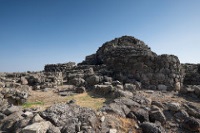
Cagliari
Cagliari is Sardinia's capital. The biggest city in the region and a busy industrial port, its old centre is charmingly compact and contained within the city walls and Pisan fortif…
Cagliari
Cagliari is Sardinia's capital. The biggest city in the region and a busy industrial port, its old centre is charmingly compact and contained within the city walls and Pisan fortifications. The main attractions are the National Archaeological Museum, which contains prehistoric tombs and other significant artefacts from the Punic and Roman periods; the impressive cathedral; and a smattering of Roman ruins.
The suburb of Poetto has a four mile (6km) stretch of sandy beach with some small bars nearby. The famous archaeological site of Su Nuraxi near Barumini is also within easy reach of the town.
Sardinia's history and culture are found in the Citadel of Museums complex: the Archaeological Museum houses artefacts from all the ancient cultures of the island, such as ceramics from Phoenician tombs, Punic jewellery and Nuragic bronzes; the Picture Gallery boasts contemporary art and sculpture; the Siamese Museum exhibits fascinating items from the East; and the university houses sculptures by wax artist Clemente Susini.
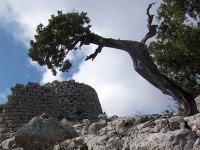
Nuraghe
Having arrived in Sardinia around 1500 BC, the mysterious Nuragic people festooned the island with about 30,000 circular fortified structures, of which 7,000 remain standing today.…
Nuraghe
Having arrived in Sardinia around 1500 BC, the mysterious Nuragic people festooned the island with about 30,000 circular fortified structures, of which 7,000 remain standing today. The complex of Nuraghe in Barumini has been added to UNESCO's World Heritage List and is the finest and most complete example of this prehistoric architecture. Other well-preserved Nuraghe can be seen at Sant Antine, while at Nora are the remains of an extensive Nuragic village including an amphitheatre, forum, baths, temple and kasbah. Other good Nuragic sites are near Villanovaforru, Alghero and Abbasanta. The purpose of the beehive-like buildings remains unknown but archaeologists assume they were used as religious temples, meeting halls and military strongholds.
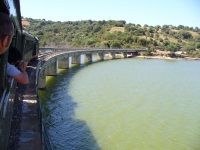
Trenino Verde
Sardinia has an unforgettable coastline, but the interior of the island is equally as beautiful. A fun way to explore it is aboard the Trenino Verde (Little Green Train), a vintage…
Trenino Verde
Sardinia has an unforgettable coastline, but the interior of the island is equally as beautiful. A fun way to explore it is aboard the Trenino Verde (Little Green Train), a vintage steam locomotive that puffs its way through forests, over bridges and through tunnels into some of the island's most scenic mountain areas. The train runs on scheduled routes, connecting Nuoro and Bosa, Sassari and Alghero, Sassari and Palau, and Cagliari and Arbatax. The train is small and tickets are limited so it's best to book in advance. The train sometimes stops at scenic spots so that passengers can stretch their legs and take photographs.
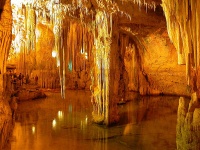
Neptune's Grotto (Grotta di Nettuno)
A popular sightseeing expedition from Alghero is a boat ride to Neptune's Grotto, an impressive deep marine cave at the bottom of the sheer cliffs of Capo Caccia. At the cave, visi…
Neptune's Grotto (Grotta di Nettuno)
A popular sightseeing expedition from Alghero is a boat ride to Neptune's Grotto, an impressive deep marine cave at the bottom of the sheer cliffs of Capo Caccia. At the cave, visitors take a 45-minute tour entering through the long meandering passage delved into the rock to view dramatically-lit stalagmites and stalactites. The contrast of the sun sparkling bright on the sea and orange cliffs against the dark depths of the cave is truly magical. But the grotto can also be reached by bus from the main terminal in Alghero, or by car, which on arrival necessitates climbing down 650 steps to the cave entrance.
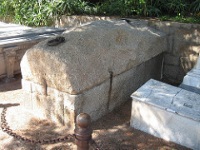
Garibaldi's House
The famous Italian general and politician Giuseppe Garibaldi lived the last third of his life on the woody, undeveloped island of Caprera. Considered a 'founding father' by Italian…
Garibaldi's House
The famous Italian general and politician Giuseppe Garibaldi lived the last third of his life on the woody, undeveloped island of Caprera. Considered a 'founding father' by Italians, he's famous for his military campaigns in South America and during Italy's unification period. The elegant homestead has been preserved as he left it and visitors can learn a lot about his lifestyle from exploring the farm; on Caprera he lived a simple, peaceful life tending his gardens and orchards. Tours of the property end with his tomb in the garden, as well as a relic room filled with some of his personal belongings and historical artefacts. For many Italians and foreign visitors Garibaldi's house and grave are a pilgrimage of sorts, a place to pay homage to a national hero.
Website www.compendiogaribaldino.it
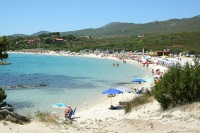
Costa Smeralda
The jet-set strip of Sardinia, Costa Smeralda is a six-mile (10km) stretch of coastline between the gulfs of Cugnana and Arzachena. The local villages and towns around Costa Smeral…
Costa Smeralda
The jet-set strip of Sardinia, Costa Smeralda is a six-mile (10km) stretch of coastline between the gulfs of Cugnana and Arzachena. The local villages and towns around Costa Smeralda have become discreet upmarket resorts, crammed with private villas, luxurious holiday villages and huge yachting marinas packed with gleaming vessels. The main town of the area is Porto Cervo, a playground of the rich and famous with its ranks of pale pink and red villas climbing the hill from the busy marina.
Another favourite retreat for celebrities is the town of Porto Rotondo, which offers a wealth of beaches, nightclubs and restaurants, most clustered around its Piazza San Marco and the marina. The main attractions are the many sequestered beaches, among the most scenic being Cappriccioli, Rena Bianca and Liscia Ruja.
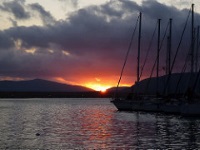
Alghero
The flourishing fishing port of Alghero is Sardinia's tourist centre, and consists of a picturesque and well-preserved old town enclosed in stout walls. Outside, the new town sport…
Alghero
The flourishing fishing port of Alghero is Sardinia's tourist centre, and consists of a picturesque and well-preserved old town enclosed in stout walls. Outside, the new town sports a grid of parallel streets, filled with hotels and restaurants. A favoured package tour destination, Alghero offers beautiful beaches, hotels and restaurants, together with numerous places of interest.
The narrow cobbled streets are lined with ornate churches, wrought-iron balconies and a number of boutiques and cafes, as well as the workshops of craftsmen working the famed coral of Alghero. The local cuisine has a taste of Spain, with Alghero renowned for its authentic Spanish paella, lobster Catalan and tasty fish soups, along with delicious sea urchin and aromatic wines.
The coast offers many secluded bays, small inlets bordered by pine forests and high, jagged cliffs. Nightlife is sedate, tending more toward sipping cocktails at a sidewalk cafe and watching the sunset.



